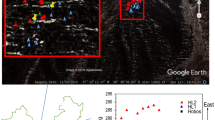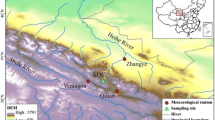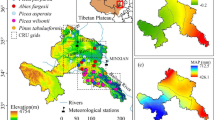Abstract
Climate affects Picea crassifolia growth and climate change will lead to changes in the climate–growth relationship (i.e., the “divergence” phenomenon). However, standardization methods can also change the understanding of such a relationship. We tested the stability of this relationship by considering several variables: 1) two periods (1952–1980 and 1981–2009), 2) three elevations (2700, 3000, and 3300 m), and 3) chronologies detrended using cubic splines with two different flexibilities. With increasing elevation, the climatic factor limiting the radial growth of Picea crassifolia shifted from precipitation to temperature. At the elevation of 2700 m, the relationship between radial growth and mean temperature of the previous December changed so that the more flexible spline had a greater precipitation signal. At the elevation of 3000 m, positive correlation of radial growth with mean temperature and precipitation in September of the previous year became more significant. At the elevation of 3300 m, positive correlation between radial growth and precipitation of the current summer and the previous spring and autumn was no longer significant, whereas the positive correlation between radial growth and temperature of the current spring and summer strengthened. The detrending with the most flexible spline enhanced the precipitation signal at 2700 m, while that with the least flexible spline enhanced the temperature signal at 3300 m. All results indicated that the divergence phenomenon was affected by the climatic signals in the chronologies and that it was most dependent on the detrending method. This suggests it is necessary to select a suitable spline bootstrap for studies of growth divergence phenomena.
Similar content being viewed by others
References
Barber VA, Juday GP, Finney BP (2000) Reduced growth of Alaskan white spruce in the twentieth century from temperature-induced drought stress. Nature 405: 668–673. DOI: 10.1038/35015049
Biondi F, Waikul K (2004) DENDROCLIM 2002: A C++ program for statistical calibration of climate signals in treering chronologies. Computers & Geosciences 30(3): 303–311. DOI: 10.1016/j.cageo.2003.11.004
Brookhouse MT, Bi H (2009) Elevation-dependent climate sensitivity in Eucalyptus pauciflora Sieb. Ex Spreng. Trees 23(6): 1309–1320. DOI: 10.1007/s00468-009-0372-6
Bunn AG, Sharac TJ, Graumlich LJ (2004) Using a simulation model to compare methods of tree-ring detrending and to investigate the detectability of low-frequency signals. Tree-Ring Research 60(2): 77–90. DOI: 10.3959/1536-1098-60.2.77
Carrer M, Urbinati C (2006) Long-term change in the sensitivity of tree-ring growth to climate forcing in Larix decidua. New Phytologist 170(4): 861–872. 10.1111/j.1469-8137.2006.01703.x
Chen F, Yuan Y, Wei W (2011) Climatic response of Picea crassifolia tree-ring parameters and precipitation reconstruction in the western Qilian Mountains, China. Journal of Arid Environments 75(11): 1121–1128. DOI: 10.1016/j.jaridenv.2011.06.010
Cook RE, Peters K (1981) The smoothing spline: a new approach to standardizing forest interior tree-ring width series for dendroclimatic studies. Tree-Ring Bulletin 41: 43–53.
D’Arrigo RD, Kaufmann RK, Davi N, et al. (2004) Thresholds for warming-induced growth decline at elevational tree line in the Yukon Territory, Canada. Global Biogeochemical Cycles 18(3): 1–7. DOI: 10.1029/2004GB002249
D’Arrigo R, Wilson R, Liepert B, et al. (2008) On the Divergence Problem’ in Northern Forests: A review of the tree-ring evidence and possible causes. Global and Planetary Change 60(3-4): 289–305. DOI: 10.1016/j.gloplacha.2007.03.004
Esper J, Frank D, Büntgen U, et al. (2010) Trends and uncertainties in Siberian indicators of 20th century warming. Global Change Biology 16(1): 386–398.DOI: 10.1111/j.1365-2486.2009.01913.x
Fang KY, Gou XH, Chen FH, et al. (2010) Tree growth and timevarying climate response along altitudinal transects in central China. European Journal of Forest Research 129(6): 1181. DOI: 10.1007/s10342-010-0408-x
Fang KY, Gou XH, Chen FH, et al. (2012) Tree growth and its association with climate between individual tree-ring series at three mountain ranges in north central China. Dendrochronologia 30(2): 113–119. DOI: 10.1016/j.dendro.2011.04.003
Griesbauer HP, Green DS (2010) Assessing the climatic sensitivity of Douglas-fir at its northern range margins in British Columbia, Canada. Trees 24: 375–389. DOI: 10.1007/s00468-009-0407-z
Gou XH, Chen FH, Yang MX, et al. (2004) Analysis of the treering width chronology of Qilian Mountains at different elevation. Acta Ecologica Sinica 24(1): 172–176. (In Chinese)
Gou XH, Chen FH, Yang MX, et al. (2005) Climatic response of thick leaf spruce (Picea crassifolia) tree-ring width at different elevations over Qilian Mountains, northwestern China. Journal of Arid Environments 61(4): 513–524. DOI:10.1016/j.jaridenv.2004.09.011
Hart SJ, Laroque CP (2013) Searching for thresholds in climate–radial growth relationships of Engelmann spruce and subalpine fir, Jasper National Park, Alberta, Canada. Dendrochronologia 31(1): 9–15. DOI: 10.1016/j.dendro.2012.04.005
Helama S, Lindholm M, Timonen M, et al. (2004) Detection of climate signal in dendrochronological data analysis: a comparison of tree-ring standardization methods. Theoretical and Applied Climatology 79(3): 239. DOI: 10.1007/s00704-004-0077-0
Holmes RL (1983) Computer-assisted quality control in treering dating and measurement.Tree-ring bulletin 43 (1):69-78.
Jacoby GC, D’Arrigo RD (1995) Tree ring width and density evidence of climatic and potential forest change in Alaska. Global Biogeochemical Cycles 9: 227–234.
Li GQ, Bai F, Sang WG (2011) Different responses of radial growth to climate warming in Pinus koraiensis and Picea jezoensis var. komarovii at their upper elevational limits in Changbai Mountain, Chinese Journal of Plant Ecology 35(5): 500–511.(In Chinese)
Li ZS, Liu GH, Fu BJ, et al. (2010) Evaluation of temporal stability in tree growth-climate response in Wolong National Natural Reserve, western Sichuan, China. Chinese Journal of Plant Ecology 34(9): 1049–1057. (In Chinese)
Li ZS, Liu GH, Fu BJ, et al. (2011) Influence of different detrending methods on climate signal in tree-ring chronologies in Wolong National Natural Reserve, western Sichuan, China. Chinese Journal of Plant Ecology 34(7): 707–721. (In Chinese)
Liu LS, Shao XM, Liang EY (2006) Climate Signals from Tree Ring Chronologies of the Upper and Lower Treelines in the Dulan Region of the Northeastern Qinghai-Tibetan Plateau. Journal of Integrative Plant Biology 48(3): 278–285. DOI: 10.1111/j.1744-7909.2006.00158.x
Lloyd AH, Fastie CL (2002) Spatial and temporal variability in the growth and climate response of treeline trees in Alaska. Climatic Change 52(4): 481–509. DOI: 10.1023/A:1014278819094
Martín-Benito D, Del Río M, Cañellas I (2010) Black pine (Pinus nigra Arn.) growth divergence along a latitudinal gradient in Western Mediterranean mountains. Annals of Forest Science 67(4): 401. DOI: 10.1051/forest/2009121
Oberhuber W (2004) Influence of climate on radial growth of Pinus cembra within the alpine timberline ecotone. Tree Physiology, 24(3): 291–301. DOI: 10.1093/treephys/24.3.291
Peng JF, Gou XH, Chen FH, et al. (2008) Difference in tree growth responses to climate at the upper treeline: Qilian juniper in the Anyemaqen Mountains. Journal of Integrative Plant Biology 50(8): 982–990. DOI: 10.1111/j.1744-7909.2008. 00688.x
Peters K, Cook ER, (1997) Calculating unbiased tree-ring indices for the study of climatic and environmental change. The Holocene 7: 361–370.
Porter TJ, Pisaric MF (2011) Temperature-growth divergence in white spruce forests of Old Crow Flats, Yukon Territory, and adjacent regions of northwestern North America. Global Change Biology 17(11): 3418–3430. DOI:10.1111/j.1365-2486.2011.02507.x
Qin L, Yuan YJ, Shi YG, et al. (2012) Effect of spline function step size on relationship between tree-ring width chronology and climate. Journal of Desert Research 32(1): 175–180. (In Chinese)
Saulnier M, Edouard JL, Corona C, Guibal F (2011) Climate/growth relationships in a Pinus cembra highelevation network in the Southern French Alps. Annals of Forest Science 68(1): 189. DOI: 10.1007/s13595-011-0020-3
Shi C, Masson-Delmotte V, Daux V, et al. (2010) An unstable tree-growth response to climate in two 500 year chronologies, North Eastern Qinghai-Tibetan Plateau. Dendrochronologia 28(4): 225–237. DOI: 10.1016/j.dendro.2009.12.002
Wang JY, Chang XX, Ge SL, et al. (2001) Vertical Distribution of the Vegetation and Water and Heat Conditions of Qilian Mountain (Northern Slope). Journal of Northwest Forestry University 16(Z1): 1–3. (In Chinese)
Wang YJ, Chen FH, Gou XH, et al. (2001) Study on Response Relationship between Tree-ring and Climate Factors and Climate Reconstruction in Middle Region of Qilianshan Mountains. Journal of Desert Research 21(1): 135–140. (In Chinese)
Wilmking M, Juday GP, Barber VA, et al. (2004) Recent climate warming forces contrasting growth responses of white spruce at treeline in Alaska through temperature thresholds. Global Change Biology 10(10): 1724–1736. DOI:10.1111/j.1365-2486.2004.00826.x
Yang YK, Liu Y, Cai QF, et al. (2005) Precipitation reconstruction from tree ring width over the central Qilian mountains for the last 248 years. Marine Geology & Quaternary Geology 25(3): 113–118. (In Chinese)
Yu DP, Wang QW, Wang Y, et al. (2011) Climatic effects on radial growth of major tree species on Changbai Mountain. Annals of Forest Science 68(5): 921–933. DOI: 10.1007/s13595-011-0098-7
Yuan YJ, Wei WS, Esper J, et al. (2008) Influence of Sampling Site and Detrending Method on Correlations and Climate Signals of Spruce Tree-ring Width Chronologies at Upper Tree Line in Western Tianshan Mountains of Xinjiang. Journal of Desert Research 28(5): 809–814. (In Chinese)
Yuan YJ, Zhang TW, Wei WS, et al. (2013) Development of treering maximum latewood density chronologies for the western Tien Shan Mountains, China: Influence of detrending method and climate response. Dendrochronologia 31(3): 192–197. DOI: 10.1016/j.dendro.2013.05.004
Zhang F, Gou XH, Su JD, et al. (2011) Age-dependent responses of tree radial growth of Pinu stabulaeformis to climate in eastern section of the Qilian Mountains. Journal of Glaciology and Geocryology 23(3): 634–639. (In Chinese)
Zhang Y, Chen FH, Gou XH, et al. (2007) The temporal and spatial distribution of seasonal dry-wet changes over the Nor thwestern China: Based on PDSI. Acta Geographica Sinica 62(11): 1142–1152. (In Chinese)
Zhang YX, Shao XM, Wilmking M (2011) Dynamic relationships between Picea crassifolia growth and climate at upper treeline in the Qilian Mts., Northeast Tibetan Plateau, China. Dendrochronologia 29(4): 185–199. DOI: 10.1016/j.dendro.2010.11.001
Zhang YX, Wilmking M (2010) Divergent growth responses and increasing temperature limitation of Qinghai spruce growth along an elevation gradient at the northeast Tibet Plateau. Forest Ecology and Management 260(6): 1076–1082. DOI: 10.1016/j.foreco.2010.06.034
Zhang YX, Wilmking M, Gou XH (2009) Changing relationships between tree growth and climate in Northwest China. Forest Ecology (39-50): 39–50. DOI: 10.1007/s11258-008-9478-y
Author information
Authors and Affiliations
Corresponding author
Additional information
http://orcid.org/0000-0002-2846-4996
http://orcid.org/0000-0001-8695-5892
http://orcid.org/0000-0002-1921-1145
http://orcid.org/0000-0002-2523-6883
http://orcid.org/0000-0002-0809-0114
Rights and permissions
About this article
Cite this article
Lei, Jp., Feng, Xh., Shi, Z. et al. Climate–growth relationship stability of Picea crassifolia on an elevation gradient, Qilian Mountain, Northwest China. J. Mt. Sci. 13, 734–743 (2016). https://doi.org/10.1007/s11629-015-3784-3
Received:
Accepted:
Published:
Issue Date:
DOI: https://doi.org/10.1007/s11629-015-3784-3




